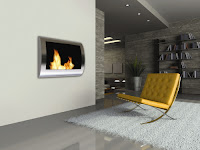Passive Houses and Bio-ethanol Fireplaces: To use a fireplace or not?
When we were designing our passive house, the floor plans initially had a location for a conventional fireplace in the great room. We quickly jettisoned the idea of its use, as conventional outside-vented fireplaces are net losers of energy when they are not in operation (which is most of the time) and when they are being used, a vast majority of heat that is generated is lost through the chimney.However my wife and I (like most in America) like fireplaces. So what were we to do? After some online research we decided to try a bio-ethanol "ventless" fireplace. Think of ethanol fireplaces as large fondue burners. That's basically what they are.
Features of bio-ethanol ventless fireplaces are:
- They can be located just about anywhere where there is sufficient air-space
- They can be hung on wall just like a flat-screen tv
- They are very contemporary in appearance and are beautiful to look at
- Some models are free-standing
- A variety of flame shapes and sizes are available
- They deliver 100% of their heat to the interior of the building
- They do not require penetrations through the air-tight building envelope
- They are clean burning, putting off only heat, moisture, and CO2 (the same as our breath)*
 |
Ventless fireplaces typically don't put off as much heat as propane, natural gas, or wood/pellet burning fireplaces but again, they direct 100% of their heat inside. Besides given the ultra low heat load requirements, who needs a super high BTU generating fireplace anyway in a passive house?
 |
| Ventless Fireplaces Can be Located Anywhere |
The ethanol fuel is generally provided in 1qt or 32oz bottles as a liquid or can as a gel and are often provided in multi-packs. There generally is a reservoir that the liquid fuel is poured into. Expect about 9 hours of burning time per unit depending upon flame level selected.
Some ventless fireplaces (or vent-free fireplaces) come with remote controlled electric ignition systems, so one can turn them off and on, like a television set.
Things we're considering as it relates to safety:
- Use of only high-quality fuel with minimal impurities
- Selection of a high-quality well-made fireplace from a reputable manufacturer
- Monitoring of CO levels with a CO detector in the room in addition to the CO detectors we have located throughout the house
- Monitoring of indoor relative humidity (moisture)
- If we find moisture issues, I will consider installing an ERV ventilation return (as we have in the bathrooms)
- The room where we would be using the fireplace is a large two story great room adjacent to the kitchen and dinette areas which have two ERV ventilation returns, providing a very large space for whats amounts to a small fire
- The capacity of the fireplace (BTU output) to be sized smaller (<12KBtu)
Some may have some real concerns operating a non-venting fireplace especially in an air-tight home, I know their use is somewhat controversial, but we're going to try one out and report how it goes. I would certainly welcome thoughtful feedback or experiences (for better or for worse) from those that have used them.
Bio-ethanol fireplace manufacturer:
* Note: The quality and purity of the fuel is important as well as the design of the fireplace to ensure complete combustion. Use of indoor air-quality monitoring equipment is recommended.


Hello,
ReplyDeleteI enjoyed reading your post. I'm building a passive house as well next spring and am wondering if you actually installed the bio-ethanol fireplace. Any issues running it in a passive house?
Thanks,
Sam